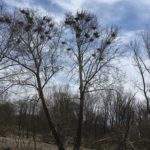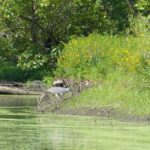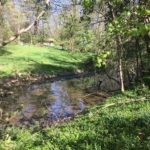Reflecting on Heron Rookeries
Guest blog by Sigrid Reynolds
Heron rookeries are one of the most peculiar sights you will see.

Photo by Sigrid Reynolds
Picture three large sycamore trees in the middle of a swamp in Ohio. Skunk cabbages, those harbingers of spring, poke up along the early pioneer road that crosses these wetlands. One narrow parking spot across the street hosts cars and vans while up to 20 nature lovers with binoculars and huge camera lenses stand on the shoulder across the street. Clacking, clicking sounds pulse from the trees that host more than a score of messy stick nests. About half of them have great blue heron silhouettes standing sentry nearby. By late April, fluffy chicks poke their heads up from under a parent. And, by June, the adolescent chicks, now the size of their parents, still demand food.
Hmmm, one’s mind drifts to adolescent humans taking over home acreage while ravenously emptying the fridge.
Great Access
This heron rookery between Cleveland and Akron, Ohio, has sheltered generations of great blue herons and has delighted visitors to the Cuyahoga Valley National Park every Spring. Rookeries abound across the US but few are as accessible as this one, less than eight miles off I-80. Along the same interstate in the Indiana Dunes, is an enormous rookery of up to 98 mating pairs. It is closed to visitors during nesting season.
Herons return each year (as do the nature photographers) and re-inhabit their nests, adding more limbs and sticks as needed. One year in a Nebraska swamp, herons arrived to find an eagle pair has appropriated their home.
Squatters
Eagles nest earlier than herons and find that their nest makes the perfect platform for more sticks. A tussle seems to go on between these two large species of birds. YouTube has intriguing videos of eagles vs. herons. Here is an amazing one. Usually, eagle activity won’t drive the herons away but does cause turmoil.
Human endeavors do drive off herons. When wetlands are drained for subdivisions, the amphibians and fish that feed herons disappear. So, these magnificent birds must seek a landscape that can sustain them and their hungry families.
Our parks and nature preserves protect these nesting sites so that we can continue to see the solitary visitors we welcome to our neighborhood ponds and creeks. I’m grateful for these preserves every time I sit on my back patio watching “our” heron arrive. He lands on a branch of my neighbor’s big pine to peruse food possibilities before he heads down to the shores of the small pond that marks our property line.
- A Heron waits patiently for a fish.
- Small pond in back yard.



